Introduction
The paper centers on one of the recent seismic events that occurred in Haiti on 12 January 2010 on a magnitude of M7.0. A rapture due to the earthquake occurred along the epicenter, some 25 km near the city of Port-au-Prince with catastrophic consequences. The discussion unfolds some of the past earthquakes and lessons learnt from them. It culminates with a discussion on the Haitian seismic event, going on with a general overview, then continues to discuss on tectonic settings, and ends with a reflection on lessons learnt or geotechnical observations that could be informative of the strategies to be put in place to minimize the adverse impact of such earthquakes in the event of their occurrence. The following map (Fig. 1) illustrates the distribution of the earthquake in Haiti as discussed later on.
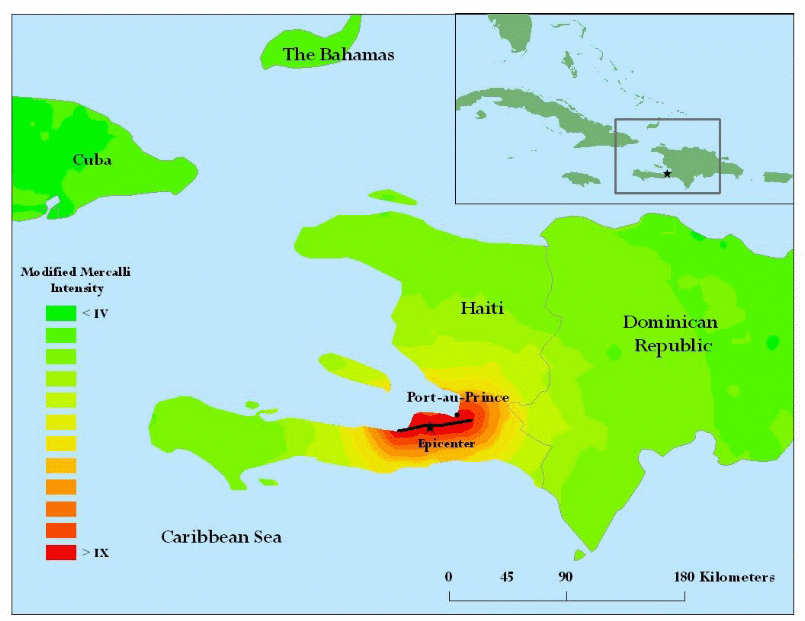
A significant amount of energy was released within 15 seconds of the shaking with an initial depth of 13 km. Then, a series of strong aftershocks followed at the western end of the rapture along the fault which continued for sometime after the shaking at different points.
It is important to note that the shaking was located between the Caribbean and North American tectonic plates which have since been identified to experience approximately 20 mm/year of plate movements that is caused by interplate thrust faulting and strike slips. The relative movement of the Septentrional fault zon and the Enriquillo-Plantain caused the seismic activity to occur on the Enriquillo-Plantain Garden fault region. A number of risk factors are associated with earthquakes with and a number of measures taken to minimize the potential impact of seismic risks (Risk Management Solutions, 2010).
Learning From Past Earthquakes
A chronology of earthquakes have been identified to come with seismic hazards identified to vulnerably subject buildings, people, and property to potential destruction leading to specific losses typical of each seismic activity. It is important to note at this point that due to the repetitive occurrence of earthquakes in various part of the world with varying intensities of seismic activities and consequences, a number of lessons have been identified to educate the population on various issues related to the safety of property and human beings. In addition to that, the probability of occurrence of these earthquakes and other engineering aspects are learning points in the discussion (Bowman & King, 2001).
One historical example to learn from, besides the Haitian quake was the seismic activity that occurred on 26 December, 2004 in the Sumatra–Java region that further led to the formation of a model with a technique to allow engineers estimate the proximity to failure with little or no prior seismic knowledge about seismic activities in an earthquake prone location (Mignan, King, Bowman, Lacassin, Dmowska, 2005).
One of the learning points is the theory of Accelerated Moment Release (AMR). Mignan, King, Bowman, Lacassin and Dmowska (2006) distinctively note the observation that AMR can be noted prior to and after a fault has occurred particularly when geological data serving as parameters to probabilistic calculations are made available to predict the probability of a future seismic event occurring. A practical application of the model to predict seismic activities was when the Sumatra–Java arc seismic activities were predicted with close precision. A stress accumulation model is illustrated in Fig. 2 below that allows seismologist to predict the nature and occurrence of a seismic activity.
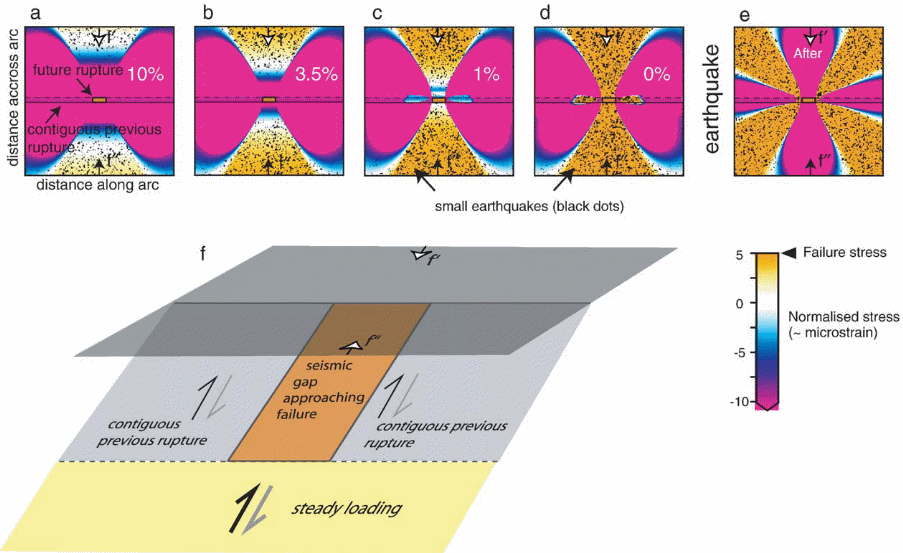
The next learning point from historical seismic activities is the availability of historical data about established patterns and damages caused by different types of earthquakes in different places. In addition to that, deep seismic activities and their consequences on population and property, the impact of potential hazards such as ground shaking, ground failures, resulting fires, destructive effects on utility devices, destruction to buildings and bridges, and contingency measures to address these issues.
Some of the measures include reinforcing buildings, disseminating information about the potential hazards to the vulnerable population, measures to address emergency services in the event of an earthquake given that utility services are not immediately available in the event of an earthquake, and knowledge about weak structures and engineering methods to strengthen them. Besides that, the design of earthquake resistant structures, the soil effects due to seismic activities, and technical knowledge such as vertical and horizontal displacements, effects on the granular structure of soils, approaches to constructing on sandy and granular foundations, foundation failures and approaches to reinforcing foundations, and liquefaction of soils due to lateral and vertical ground movements, and techniques for causing saturated soils to drain.
A typical example was when the ground beneath a building in 1999 in Turkey led to dangerous tilting of buildings leading to ground capacity failures. Another historical earthquake was when an earthquake destroyed port facilities in Japan in 1995 significantly reducing the functional operability of the port by a large percentage (Bowman & King, 2001).
On the other hand, engineers get knowledge on the probability that an earthquake is likely to return based on probabilistic models and historical data, knowledge about site effects as illustrated in the fig. 3 below.
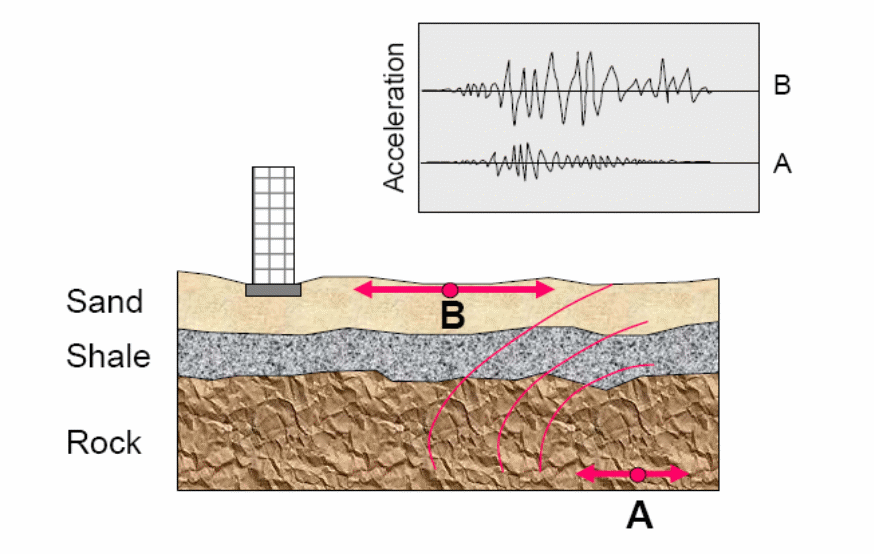
Examples of earthquakes that have inspired seismologists include the 1949 Olympia with a fault line experienced along the southern edge of Puget Sound measuring M 8.6 magnitude with a destructive effect illustrated on the Fig. 3 below.
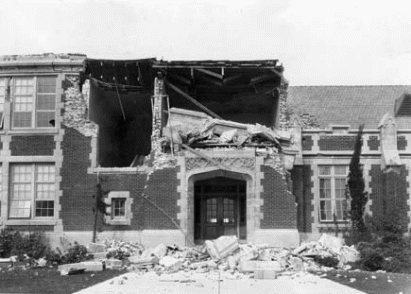
General Overview
Having discussed about the potential impact of hazards due to seismic activities, it is important to have a general overview of seismic activities as detailed below. One typical example is the Haitian earthquake and its devastating consequences as indicated and discussed elsewhere (Mora, S. 2010).
When the earth released energy due to accumulated strain from its interior along a line of weakness or fault, the energy in the form of seismic waves was solely responsible for Haitian earthquake. It is important to note that when the faulting was over, the trapped energy continued to be seismically released between several hours and several days (Mora, S. 2010).
Seismographs detect earthquakes ranging from small to extensive shakings that cause minor to major damages. Damage can be overwhelming. One other such example besides the Haitian quake was an earthquake that hit the City of Lisbon in 1976 causing an estimated death toll of 600,000 people. At that time, it was realized that seismic energy caused damage by igniting a series of other destructive elements such as fires due to gas and electricity, collapsing buildings and other forms of destructions making it difficult to fight the conflagrations. Research reports and historical data indicate that seismic activities were usually restricted to specific lines of faults and not just randomly. The faults responsible for a number of shakes are illustrated in the fig. 4 below.
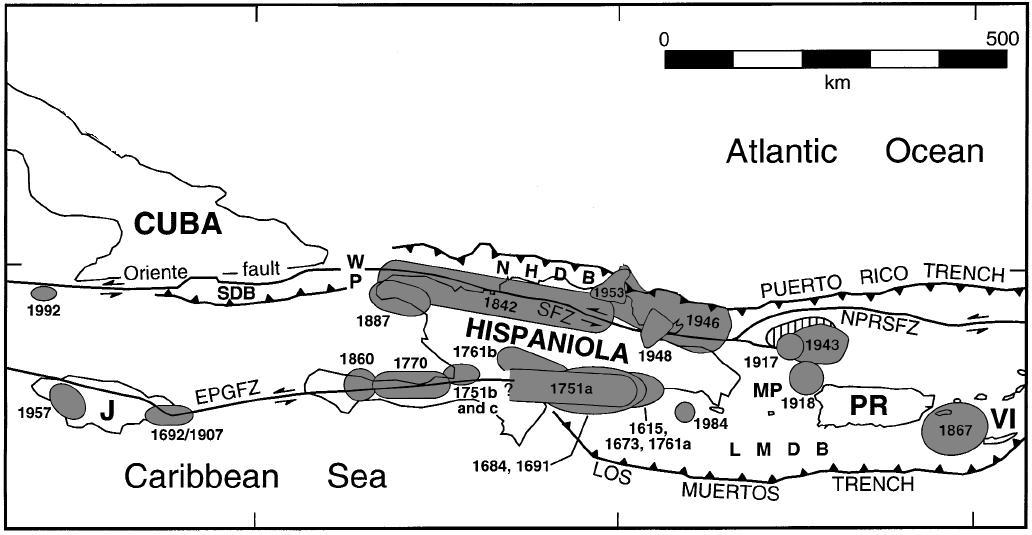
The scope of property damage of the Haitian quake placed a number of properties at the potential risk to destruction due to the fact that Haitian buildings and other structures have not integrated any earthquake resistance techniques into the structures (Mora, S. 2010). Thus, the vulnerability of the structures such as bridges, buildings, tunnels, utility lines and other essentials were susceptible to instant destruction upon the incident seismic wave. In addition to that, fatalities from earthquakes are huge at times. Typically, the Haitian earthquake is estimated to have caused close to 250,000 fatalities despite some discrepancies in estimating the fatalities.
Characteristically, the Haitian earthquake and related hazards and risks with a comeback probability are typically due to tectonic seismic activities along the North American plates and the Caribbean recur with varying intensity for the last 400 years they have been experienced. Probability indicates a future recurrence of earthquakes due to the characterizing movements with equally associated hazards and other potential risks (Mora, S. 2010).
Tectonic Setting
Theoretically and in practice, Haiti lies on the Greater Antilles located on a tectonic plate that forms a boundary between the North-American plate and the Northern Caribbean edge a region susceptible to earthquake hazards and associated risks as illustrated on the Fig. 6 below.

The region is characterized by a strike-lip left-lateral motion where relative movements of tectonic plates occurs between the North American plate and the east-northeast occur as illustrated in fig. 7 and Fig. 8 below.
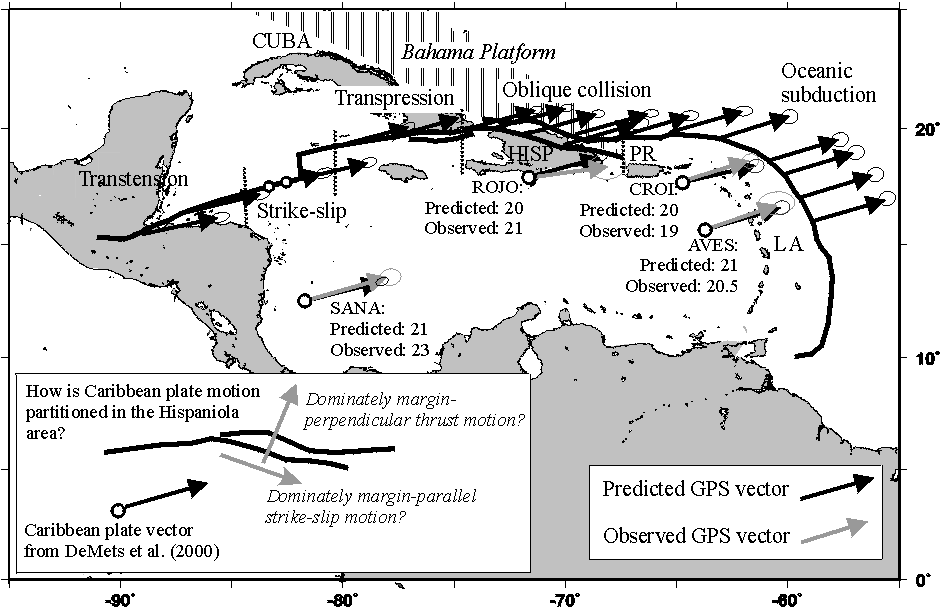

Based on the tectonic movements illustrated above, slip friction between the plates mentioned above along the fault line and elastic rebound occur between the boundaries causing a series of sudden intense seismic vibrations with the inherent property of stick slip amounting to frictional sliding. That was followed by disruptive chatters at the boundaries leading to excessive strains eventually causing abrupt seismic vibrations along the fault line. Typically the energy stored due to these movements was released as an earthquake that struck Haiti with destructive consequences (Nettles & Hjörleifsdóttir, 2010).
According to the theory of elastic rebound, vertical and lateral movements along the fault lines were experienced where rocks relatively linked to each other and without any restraint experienced a significant distorting movement, followed by slippage and gradually a return of the rocks to their previous positions (Mann, Matumoto & Burke, 1984).
Notably, the Haiti earthquake occurred once followed by aftershocks of different magnitudes for several days, classifying the earthquake into the category caused by tectonic movements. However, other tectonic settings issues related to plate movements due to earth shaking contributed immensely to the strength of the earthquake (M.7 Haiti Earthquake of January, 2010).
However, it is important to note that Haiti is a poor country and setting up advanced data gathering equipments and earthquake monitoring devices may cost a fortune, leaving property and the people still vulnerable to new unpredicted earthquakes. However, it is important to quickly add that it is difficult or near to impossible to predict with precision the possibility of the occurrence of an earthquake (M.7 Haiti Earthquake of January, 2010).
However, in the event of an earthquake, contingency measures have to be put in place to ensure the vulnerable are educated and measures put in place to mitigate upon the risks and potential catastrophes. On the other hand, it is important to develop theoretical models to integrate the concept of seismologic observations, geologic and geodetic to develop a predictive model of the probabilistic occurrence of these earthquakes. It is important to note that various learning points have been established from the lessons of the above earthquakes as discussed below (M.7 Haiti Earthquake of January, 2010).
Geotechnical Observations
Geotechnical observations made from the above discussion indicates that seismic vibrations within the earth result from disruptive energy that travels in waveform and which is stored up during the earth’s tectonic movements. The movements between different plates are the potential source of earthquakes. The movements of these plates can be established based on the stress accumulation model (M.7 Haiti Earthquake of January, 2010).
Therefore, the earthquake energy is released due to faulting and strike slips. These movements are potential sources of destruction to vulnerable people and property and the probability of recurrences can be modeled though not with near precision (Puebellier, Mauffret, Leroy, Vlia & Amilcar, 2000).
On the other hand, soil activities during the movements, liquefactions of soil, and granularity of soil indicate further potential ground stability weaknesses subjecting structures to high risks of destruction. However, there is need to set up contingency measures to overcome the potential effects of earthquakes to vulnerable people, property, utility devices such as electricity and gas supplies before any intervention is made. It is important to consider geotechnical issues in designing structures including the liquefaction potential of soil, slope embankments and reinforcements, determine the parametric issues related to structures such as tunnels, buildings, and utility facilities in preparation for the eventuality of an earthquake in vulnerable areas.
References
Bowman, D.D., King, G.C.P. 2001. Accelerating seismicity and stress accumulation before large earthquakes, Geophys. Res. Lett. 28 4039–4042.
M.7 Haiti Earthquake of January, 2010. Web.
Mann, P., Matumoto, T. & Burke, K. 1984. Neotectonics of Hispaniola_plate motion, sedimentation, and seismicity at a restraining bend. Earth Planet. Sci. Lett. 70, 311_324.
Mignan, A., King, G., Bowman, D., Lacassin, R., Dmowska, R. 2005. Seismic activity in the Sumatra–Java region prior to the 2004 (Mw=9.0–9.3) and 2005 (Mw=8.7) earthquakes. Web.
Mora, S. 2010. Brief introductory note on earthquake hazards in Haiti. Web.
Nettles, M. & Hjörleifsdóttir, V. 2010. Earthquake source parameters for the January 12 Haiti main shock and aftershock sequence. Geophys. J. Int. 183, 375_380.
Puebellier, M., Mauffret, A., Leroy, S., Vlia, J. M. & Amilcar, H.2000. Plate boundary readjustment in oblique convergence: Example of the Neogene of Hispaniola, Greater Antilles. Tectonics 19, 630_648 (2000).
Risk Management Solutions. 2010. RMS FAQ: 2010 Haiti Earthquake and Caribbean Earthquake Risk. Web.